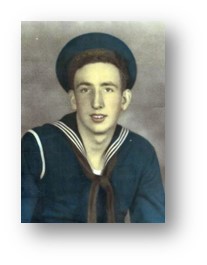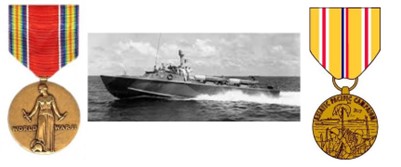Name: Lassen, Foster Carl, MoMM3, USN
Local address: 25 Beachwood Terrace, Matawan, NJ
Foster, born January 3, 1925 in Glenridge, NJ, was the first of two children of John Charles Lassen (1899-1937) and Hazel L. French (1906-1923). His father, a house painter, died when Foster was 12 leaving his mother to raise him and his eleven-year-old sister. The family resided in Union Beach – Foster attended the Cottage Park School as a youth and was active in Boy Scout troop 56.
On January 5, 1943, two days after his 18th birthday, Foster registered for the draft in Atlantic Highlands. The record indicated he was 5’ 6 ½ inches tall, 130 pounds, hazel eyes, black hair with a ruddy complexion. He had had an appendectomy when he was 17 and the scar was noted on the record. Foster was employed at Camp Kilmer, a staging area for troop deployment near Piscataway, when he registered.
Foster enlisted in the Navy on September 25, 1943 and reported to basic training Oct 4th. Upon completion of training, he was assigned to Motor Torpedo Boat Squadron 37 operating out of the Brooklyn Navy Yard when it was commissioned on June 5, 1944. He was promoted to Motor Machinists Mate 3rd class, with the responsibility of the boat’s mechanical systems and was assigned to PT 533 commanded by LT (jg) Harold DeFelice.
The first months were dedicated to outfitting the boats and “shake down” cruises on the eastern seaboard. On August 1, 1944, Pt-533 and three others were loaded aboard the SS Fred W. Weller at Pier #7 on the Hudson River for transport overseas.
On August 18th the Weller reached the Panama Canal and PT 533 and its companions were offloaded at the submarine base at Coco Solo. The following day, with a pilot on board, the boats transited the canal and arrived at the US Naval Station at Taboga Island. The boats then underwent extensive training in the area, consisting of day and night firing, navigation drills and hunting targets in darkness. On November 1st, the boats were loaded on the Esso Manhattan for transit to Tulagi in the Solomon Islands, arriving there on November 29th. The boats were offloaded the following day, and took up station near their tender, the USS Silenus (AGP-11).
On December 19th after a training period, the boats in the squadron left for their forward operating base at Stirling Island, 300 miles to the west. Their primary assignment was to patrol off Bougainville and Choiseul Islands.
The day after Christmas 1944, the squadron commenced its first offensive operation, a combined dawn air and sea strike of a Japanese bivouac and supply area on the southwest coast of Bougainville. This attack was to provide a diversion for Australian troops operating to the north. The strike force consisted of all the Squadron 37 boats, LCI gunboats and a dozen F4U Corsairs. After expending over 37,000 rounds of ammunition, and receiving in return sporadic enemy small caliber fire which did no damage, the boats withdrew after about two hours and returned to base.
The squadron continued patrolling in the area until February 15, 1945, when they left their forward base and returned to Tulagi, and after a two day stop there, proceeded Star Harbor in San Cristobal in the Solomon Islands. On the 20th, they departed for Espiritu Santo Island in New Hebrides, where they awaited orders. While there, they trained and were used in air-sea rescue operations. They were at this base when the war ended in August.
Foster returned to Union Beach after the war and married Edna Little in 1947. He attended trade school and became a mechanic, and subsequently worked at IFF as an instrument specialist. He and his wife had seven children – son Brent, who followed his father’s footsteps in the navy, was killed when his cruiser collided with an aircraft carrier in 1975. Brent has been added to the Matawan Historical Society’s Wall of Honor.
Foster died on December 30, 2018 and is buried in the Brigadier General William C. Doyle Memorial Cemetery, Arneytown, NJ.


NO COMMENTS